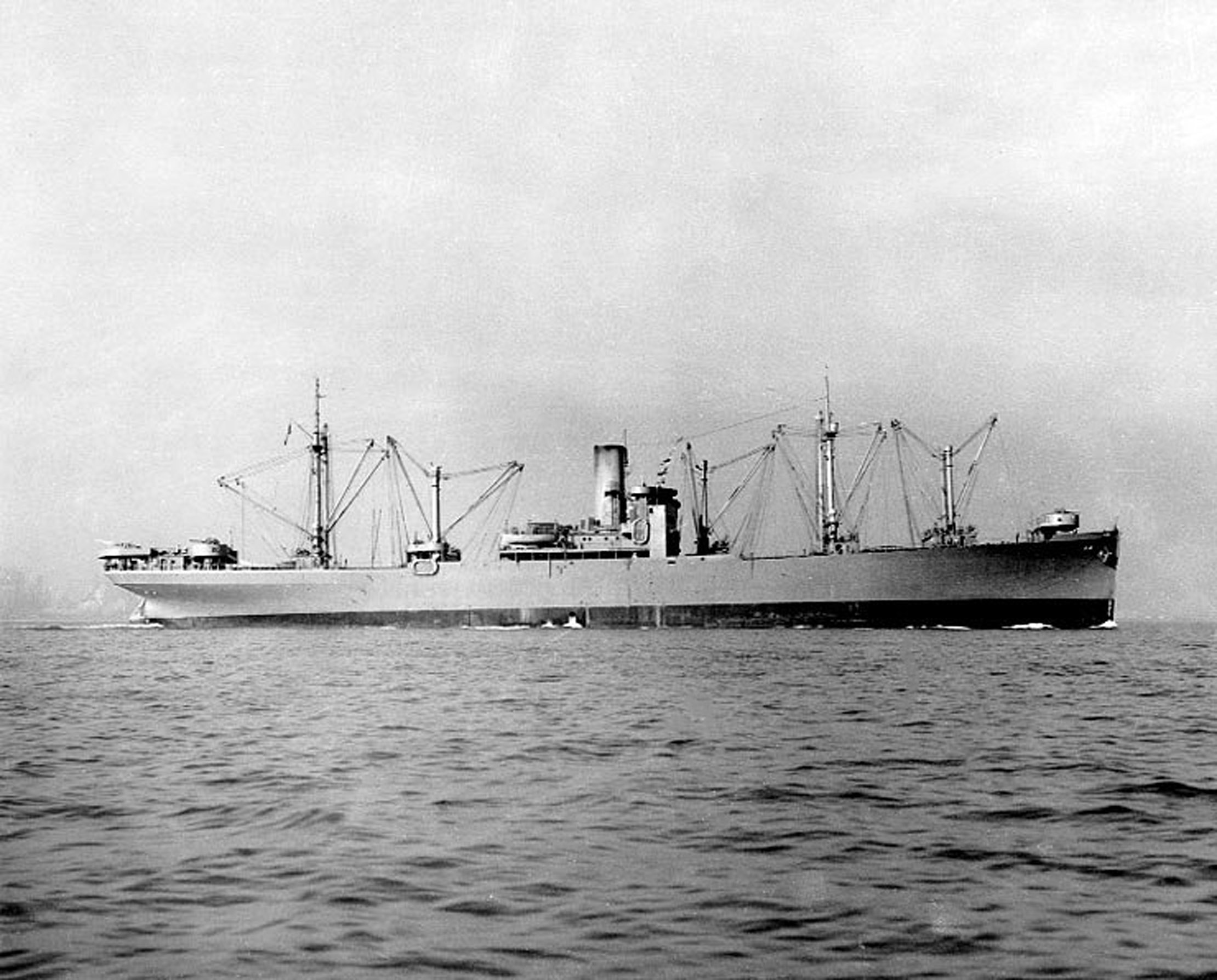

Elmore After the War

Elmore's Post-War Career
Maritime Commission:
- USS Elmore (APA-42) was decommissioned on 13 March 1946 at Mobile, Alabama.
- Returned to the Maritime Commission, 15 May 1946, for disposal, name reverted to SS Sea Panther
- Sold for commercial service, 22 May 1947, to Pacific Transport Lines, renamed SS China Transport
- Sold to States Lines (States Steamship Co.) in August 1957, renamed SS Oregon
- Renamed SS Idaho, 30 December 1959
- Title transferred to the Maritime Administration, 20 May 1966 (trade-in program)
- Returned to the Maritime Administration, 4 August 1969, at Olympia, WA.
- Final Disposition sold for scrapping, 30 April 1971, to American Ship Dismantlers Inc. (PD-X-901 dated 13 April 1971) for $73,111.00.
- Scrapped at Portland, Oregon in 1971
Source: Wikipedia
Soon after returning to the states performing "Magic Carpet" duty, USS Elmore was decommissioned at Mobile, Alabama on 13 March 1946 and returned to the Maritime Commission for sale 15 May 1946. After decommissioning, Elmore's name reverted to Sea Panther when she was leased in 1946 for commercial service by Pacific Transport Lines (PTL). In 1947 she was renamed China Transport. In 1958, the States Steamship Company acquired the Pacific Transport Lines and renamed the ship Oregon. In 1960, the ship was renamed Idaho. The vessel was returned to the Maritime Administration in 1966 and scrapped at Portland, Oregon in 1971.
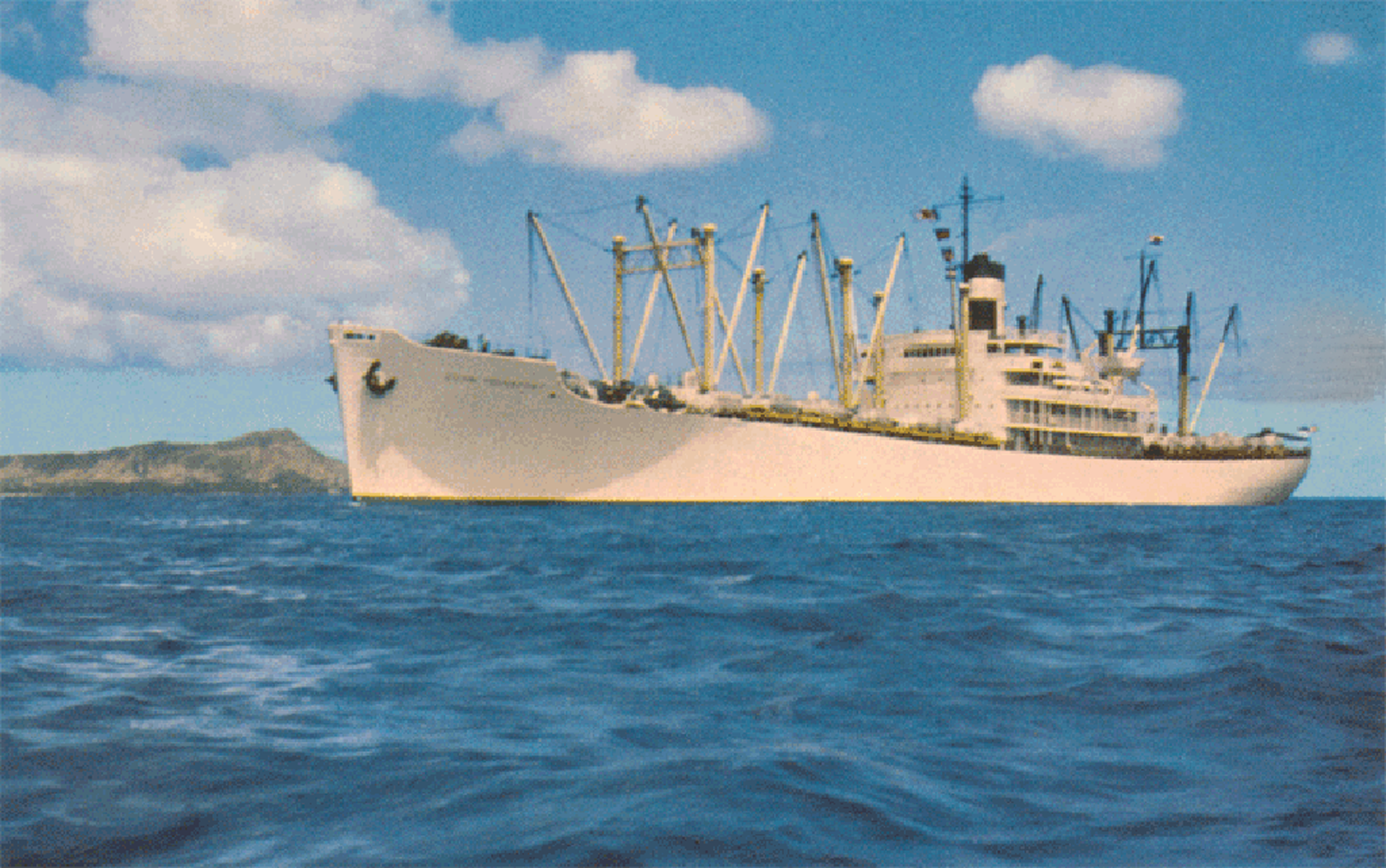
SS China Transport (former USS Elmore) of Pacific Transport Lines (PTL) [1947-1957] in Hawaii. Click to zoom
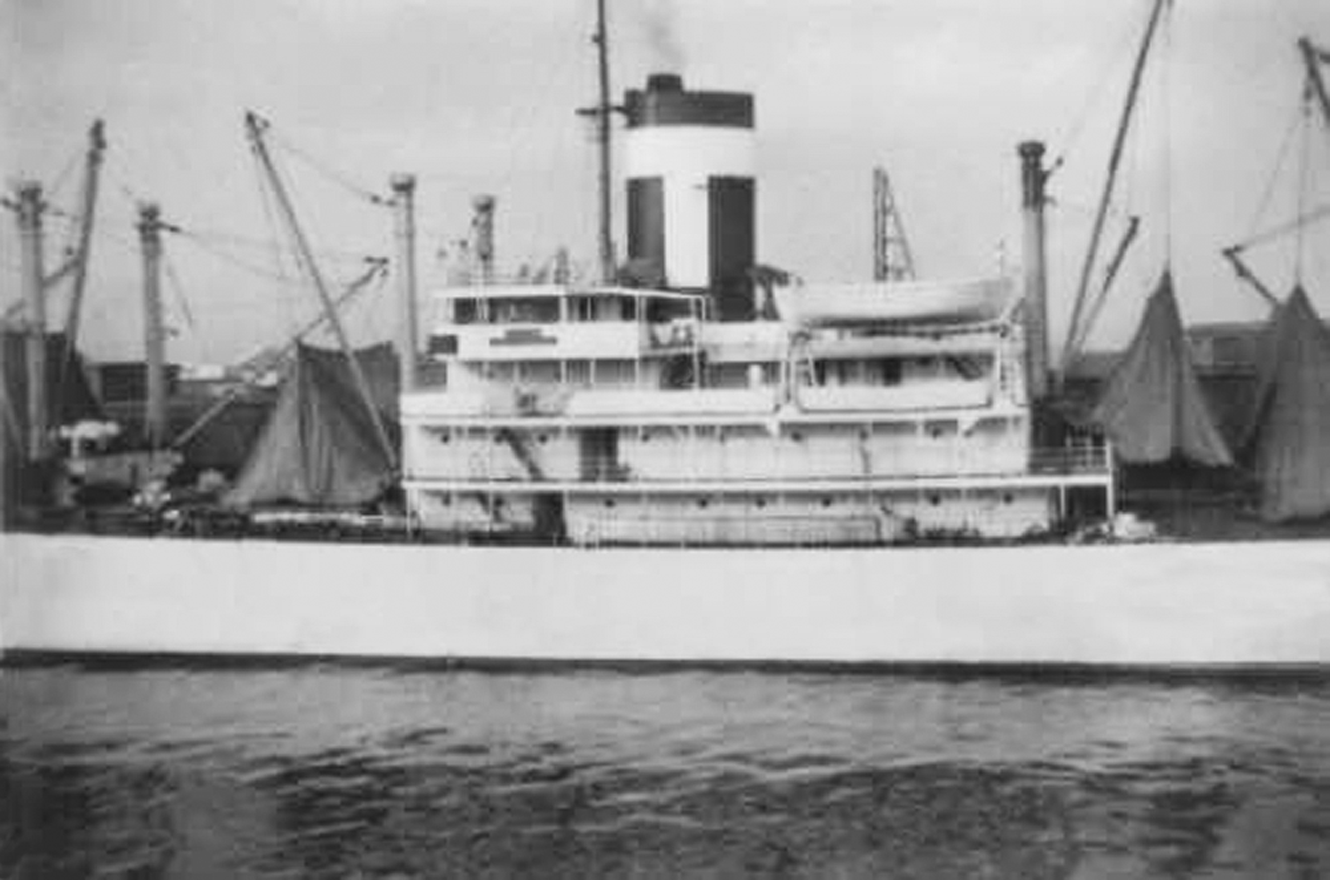
SS China Transport, Pacific Transport Lines, at San Francisco, 1952. Provided by Chuck Durand. Click to zoom
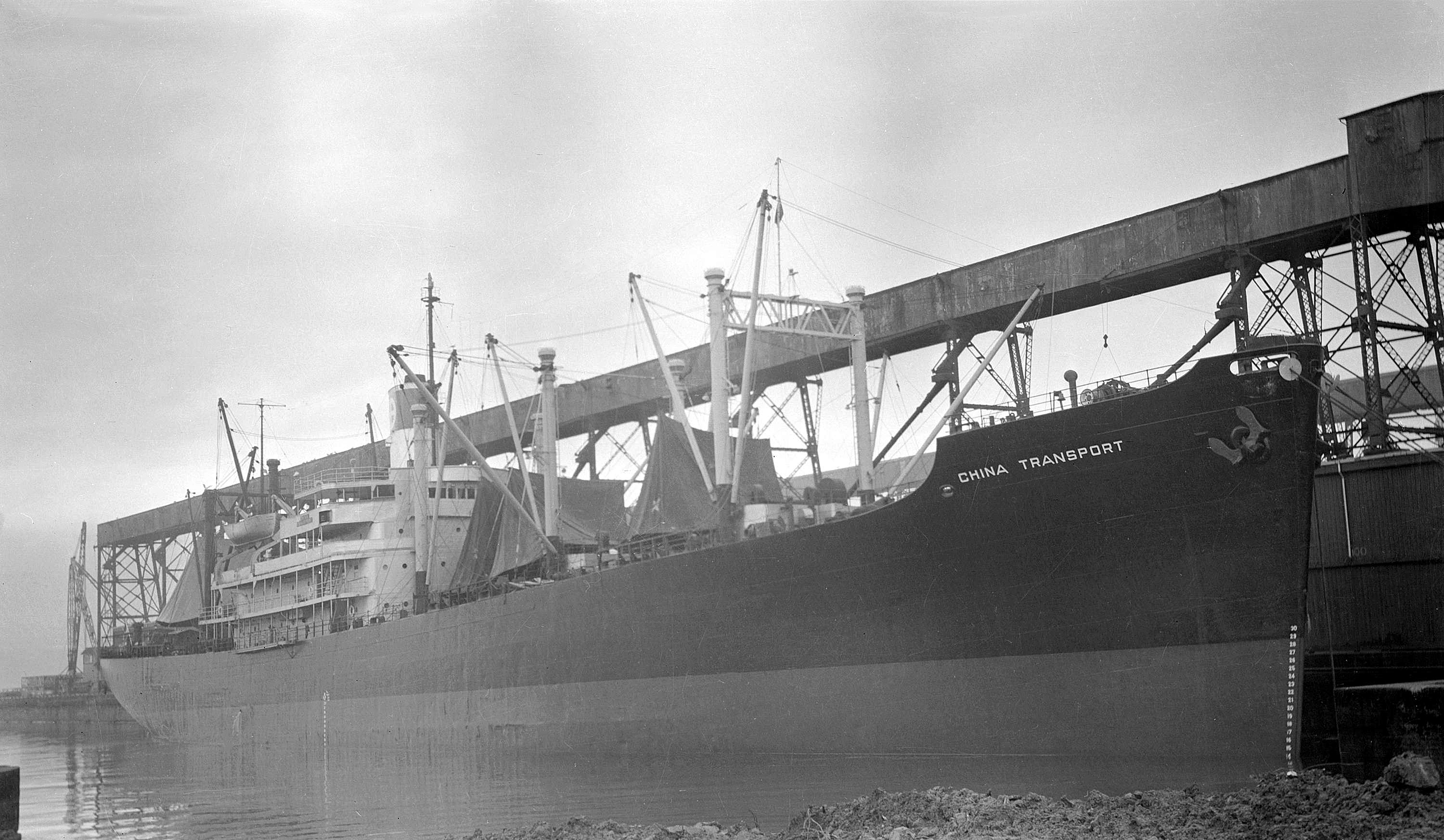
SS China Transport at dock, Pacific Transport Lines, at Vancouver, BC, Canada on 26 Feb 1957. City of Vancouver Archives. Photograph by Walter E. Frost. Click to zoom
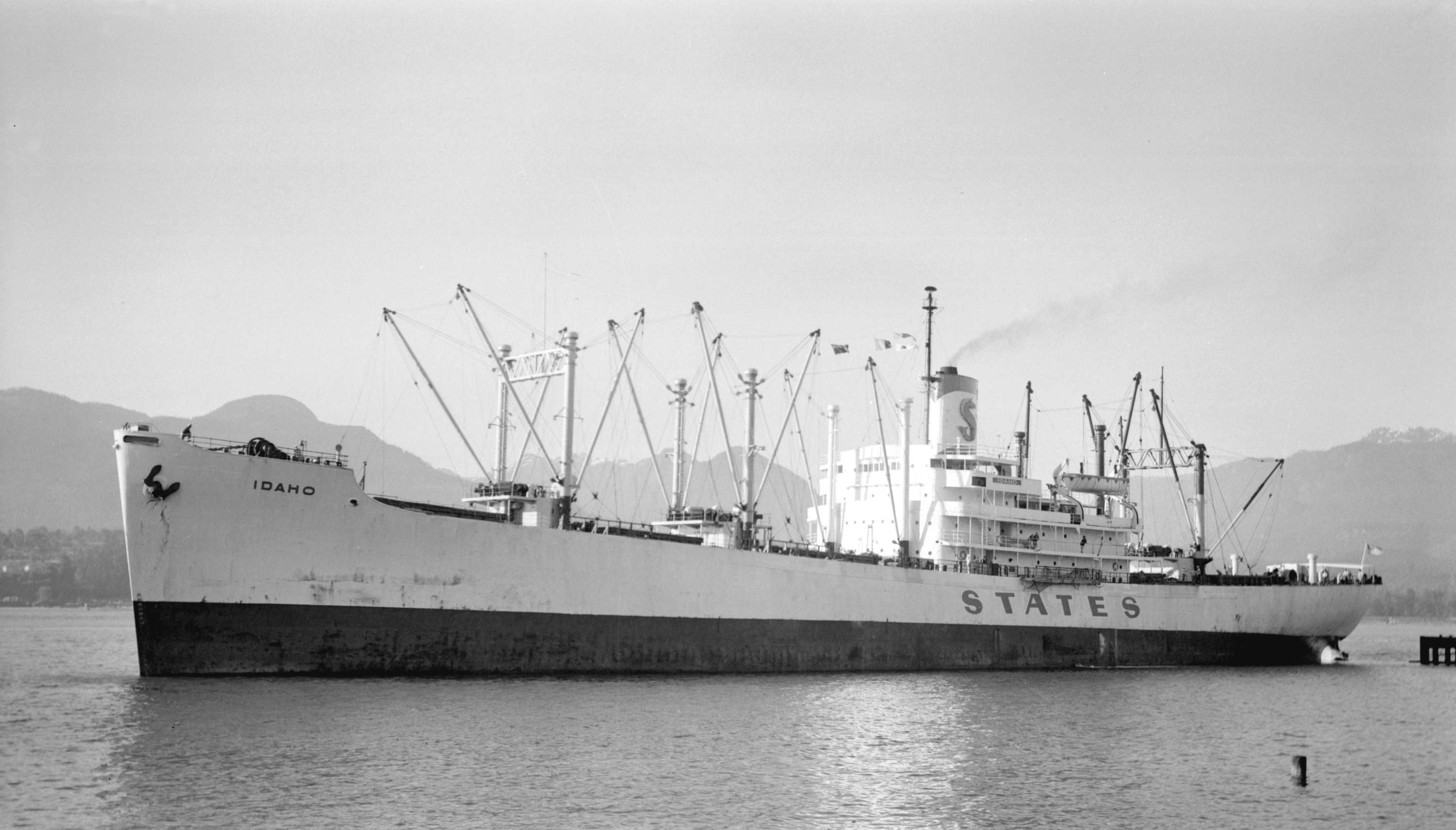
SS Idaho, States Steamship Co., at Vancouver, BC, Canada on 11 June 1960. City of Vancouver Archives. Click to zoom
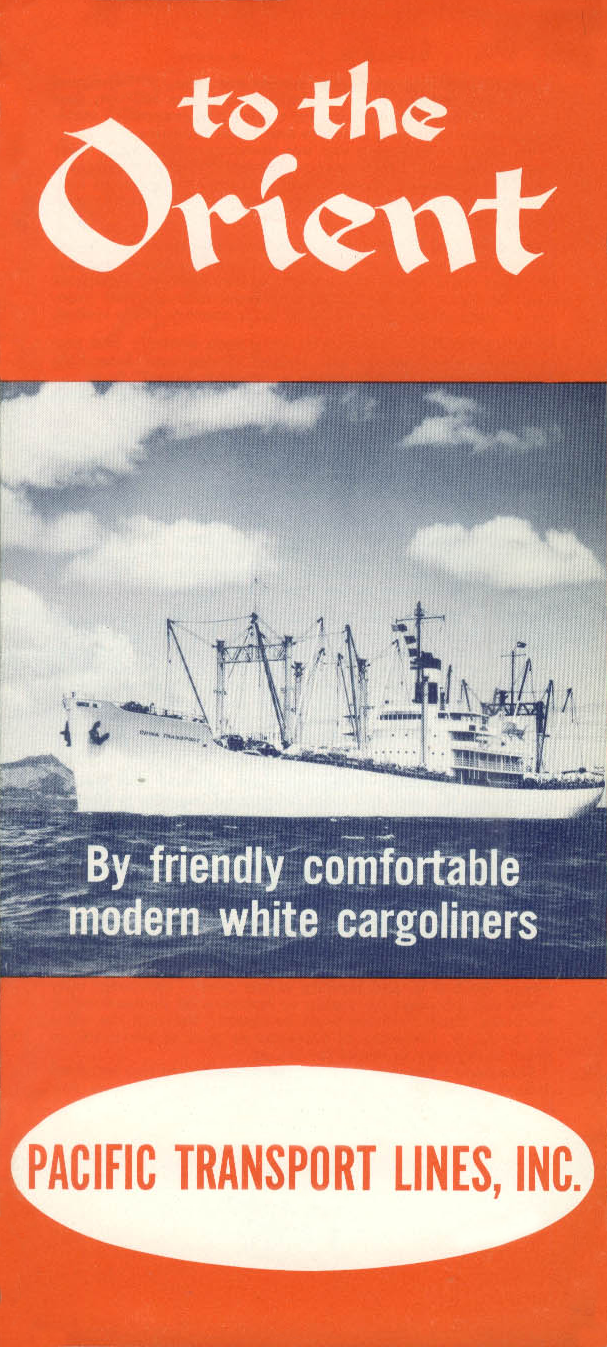
Pacific Transport Lines (PTL) brochure, circa 1950. The photo features SS China Transport (former USS Elmore), a modern white cargoliner. Click to zoom.
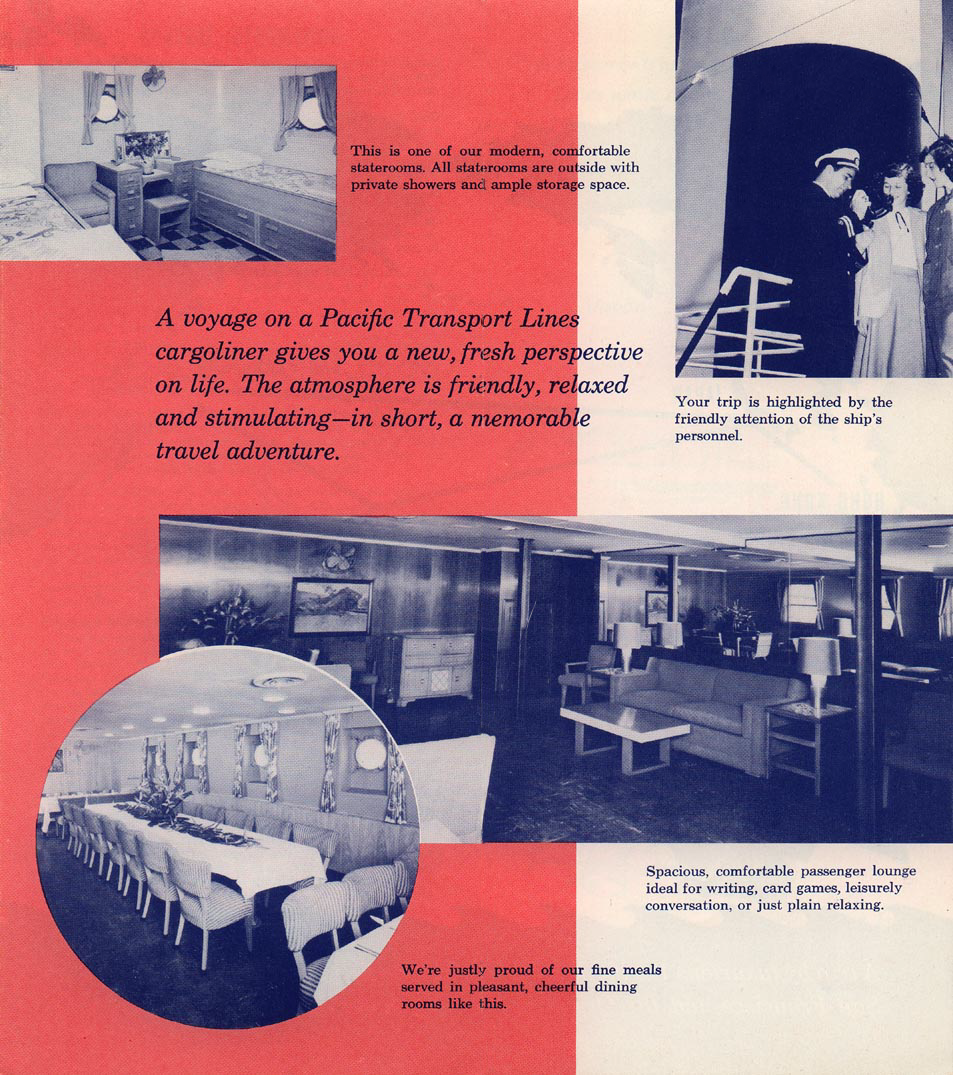
Interior of brochure (above). PTL spared no expense in converting Elmore to commercial use. The crew of the Elmore would not recognize this ship. Click to zoom.
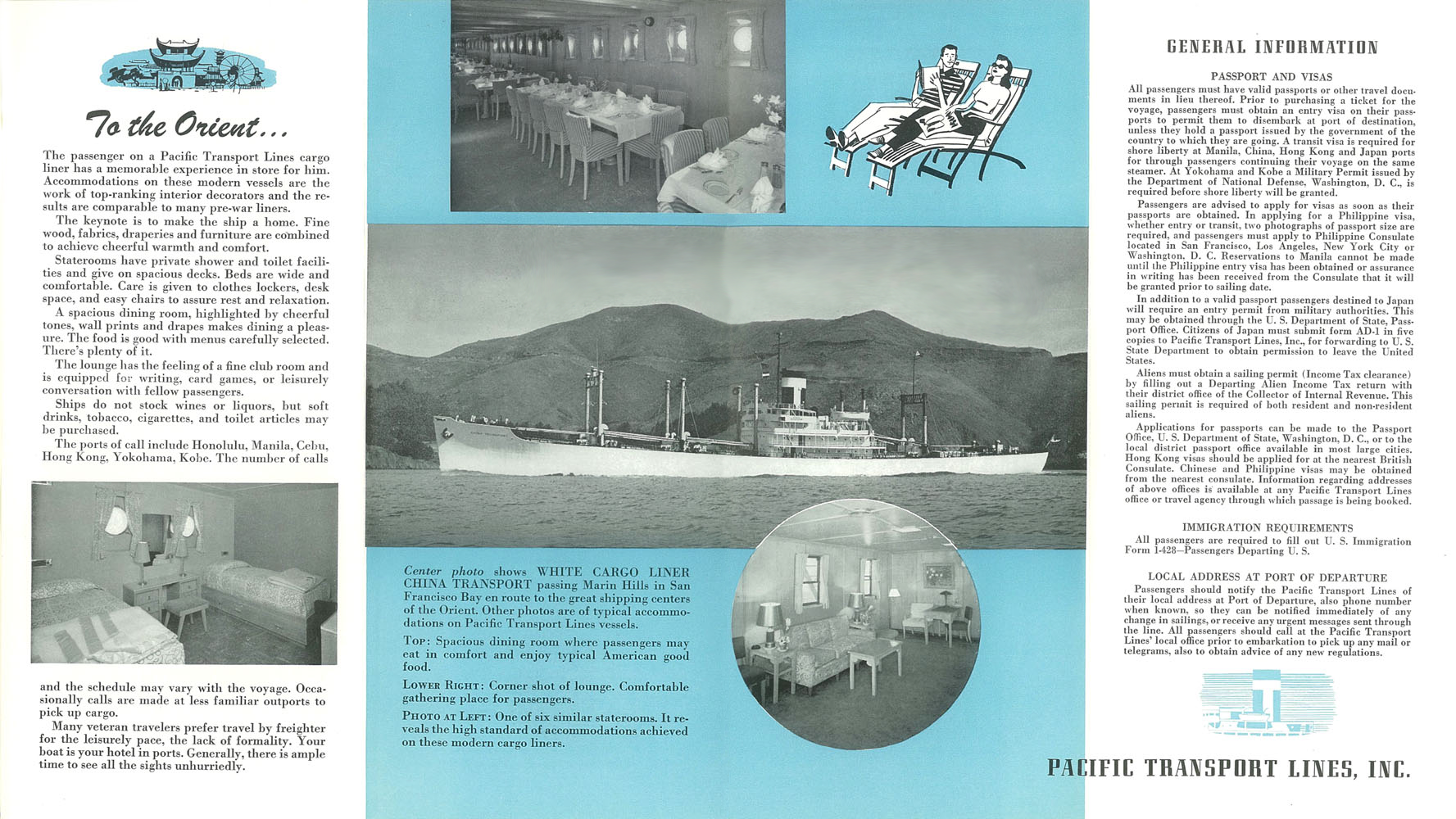
Pacific Cargo Lines (PCL) converted their WWII transports into cargo liners. These were tramp steams but on a regular schedule. Revenue was generated by providing both passenger accomodations (first-class accommodation for 20 passengers) and cargo shipment. Click to zoom.
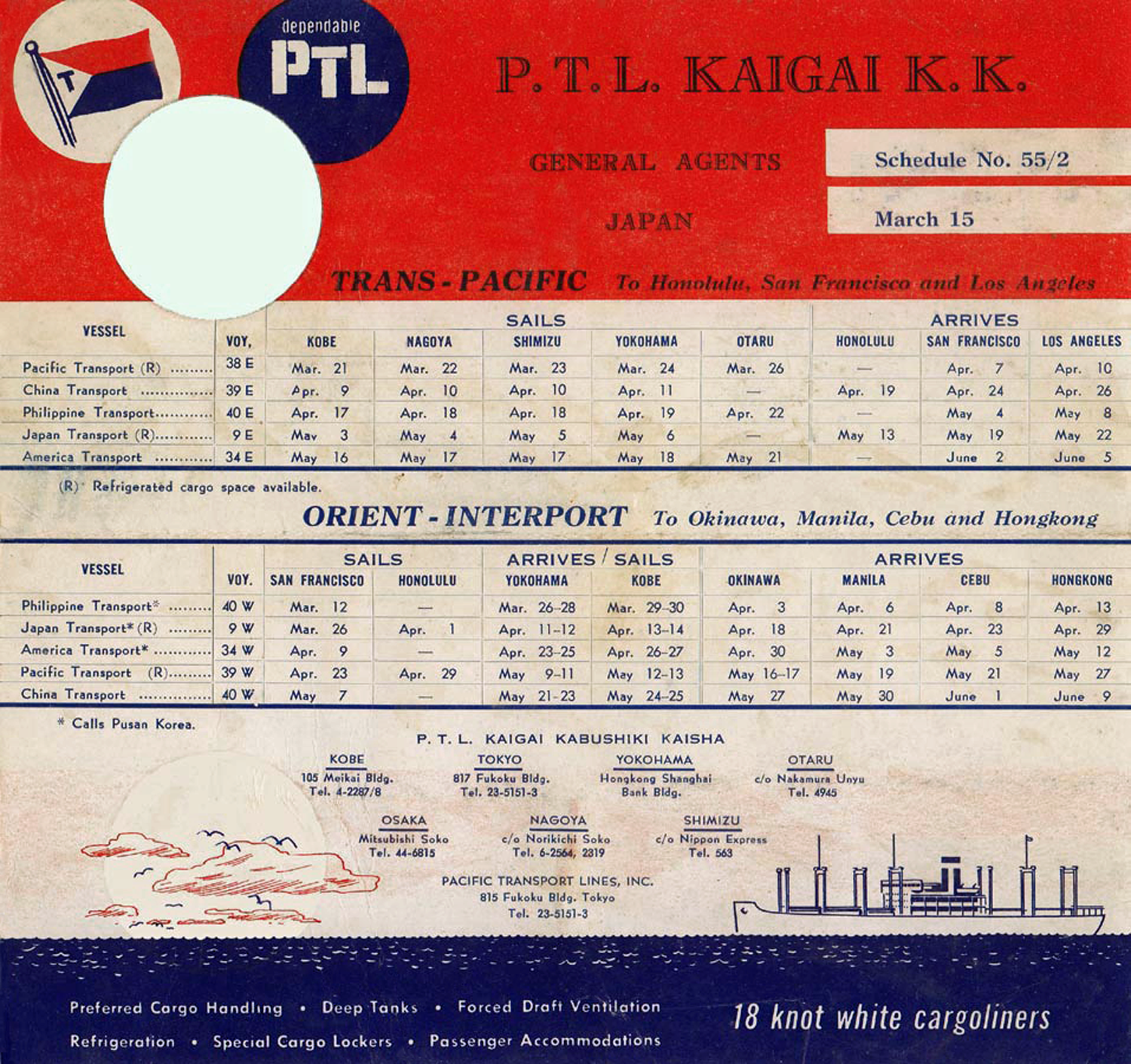
PTL sailing schedule, March-May, 1955 (issued March 15, 1955). The brochure lists five ships in the PTL fleet: Pacific Transport, China Transport (former USS Elmore), Philippine Transport, Japan Transport, and America Transport. Click to zoom.
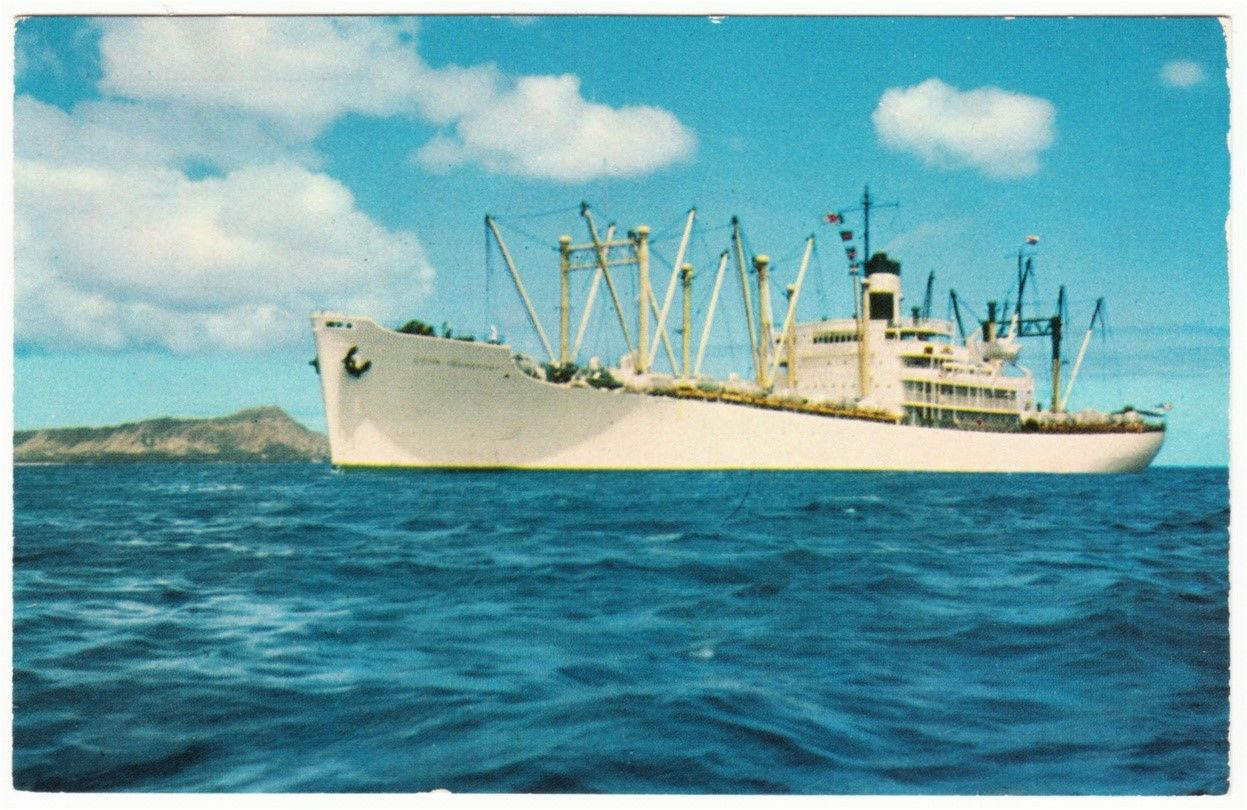
PTL advertisement postcard (front) featuring SS China Transport. Click to zoom.
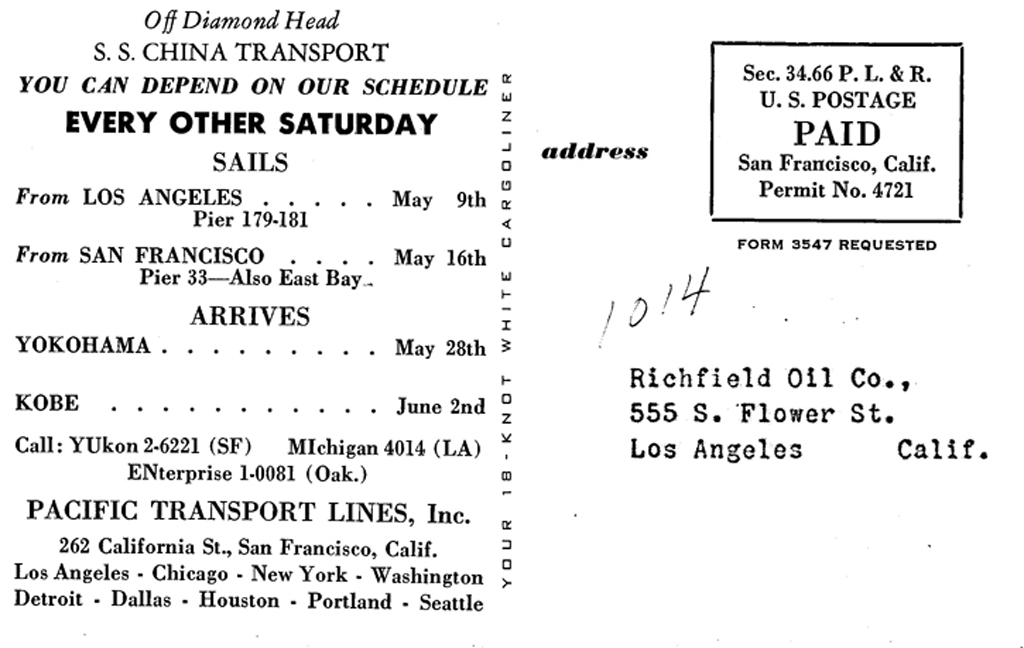
PTL advertisement postcard (flipside) featuring SS China Transport. Click to zoom.
Source: Schedules are from the collection of Björn Larsson at timetableimages.com.

When USS Elmore (APA-42) was converted into a cargo liner after the war, it was more than just a simple change of utility. Shipping lines such as Pacific Transport Lines and States Lines converted such former Navy ships into what they called "berth liners" which were ships that ran on schedules and had accommodations ("berths") for up to 12 passengers. These ships also transported cargo such as grain, pulp, lumber, and hides across the Pacific to the Orient and would return to the United States with manufactured goods such as plywood, porcelain, transistor radios, cameras and automobiles from Japan. These vessels would typically have a crew of about 50.
It should be noted that this type of operation is different from what is called the "tramp trade." A steamship engaged in the tramp trade is called a "tramp steamer." A tramp steamer is a ship that does not have a fixed schedule or published ports of call. As opposed to freight liners, tramp ships trade on the spot market with no fixed schedule or itinerary/ports-of-call(s). The revitalized USS Elmore was never a "tramp steamer."

Click on the links below to access newspapers articles and ads regarding the post-war commercial versions of USS Elmore – SS China Transport, SS Oregon and SS Idaho. Swipe right to see more stories.
San Pedro News-Pilot, San Pedro, California • November 20, 1948
Fire in the cargo holds of Pacific Transport Lines (PTL) ship SS China Transport estimated at $75,000 ($850,000 in 2021 dollars). Captain Gregory Johnson, skipper.
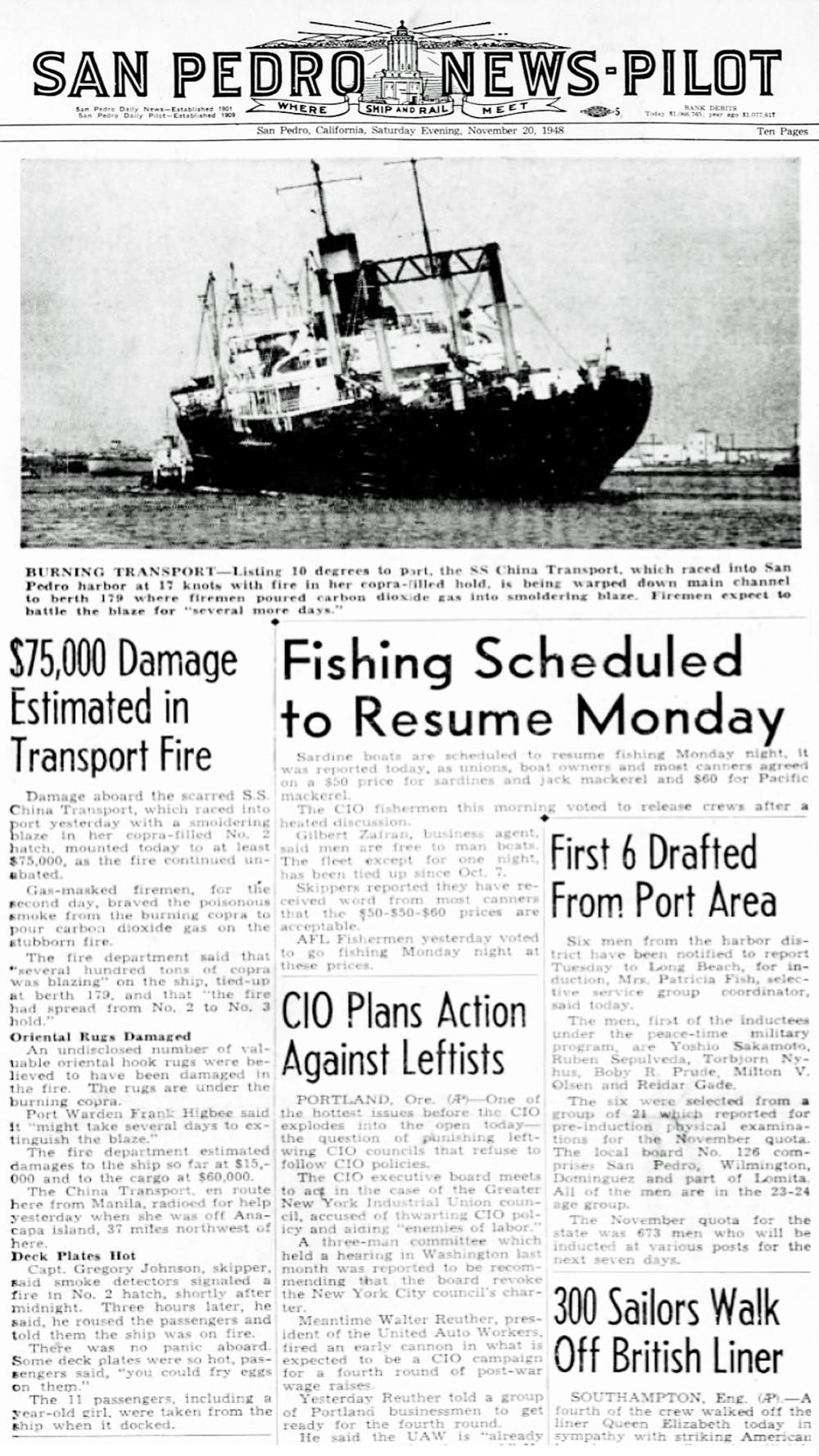
Wilmington, Journal-Press, Wilmington, California • January 16, 1952
Captain Axel M. Hansen, skipper of the Pacific Transport Line ship, SS China Transport, meets with Pan Am Pacific Airline pilot Joe Barrows to exchange information on their respective jobs in transiting across the Pacific Ocean.
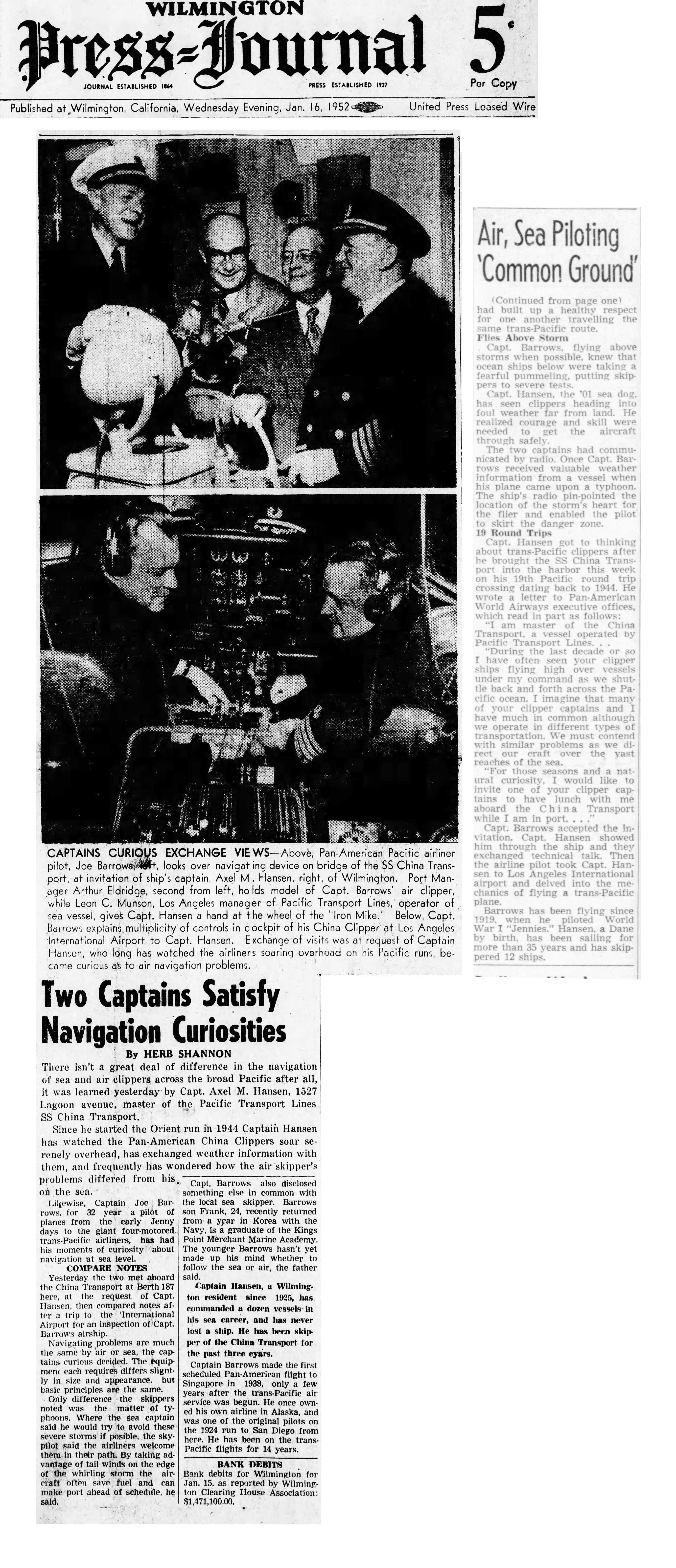
The World, Coos Bay, Oregon • October 23, 1964
Captain Eugene West returns to his home town of Coos Bay, Oregon as skipper of the States Line ship, SS Idaho.
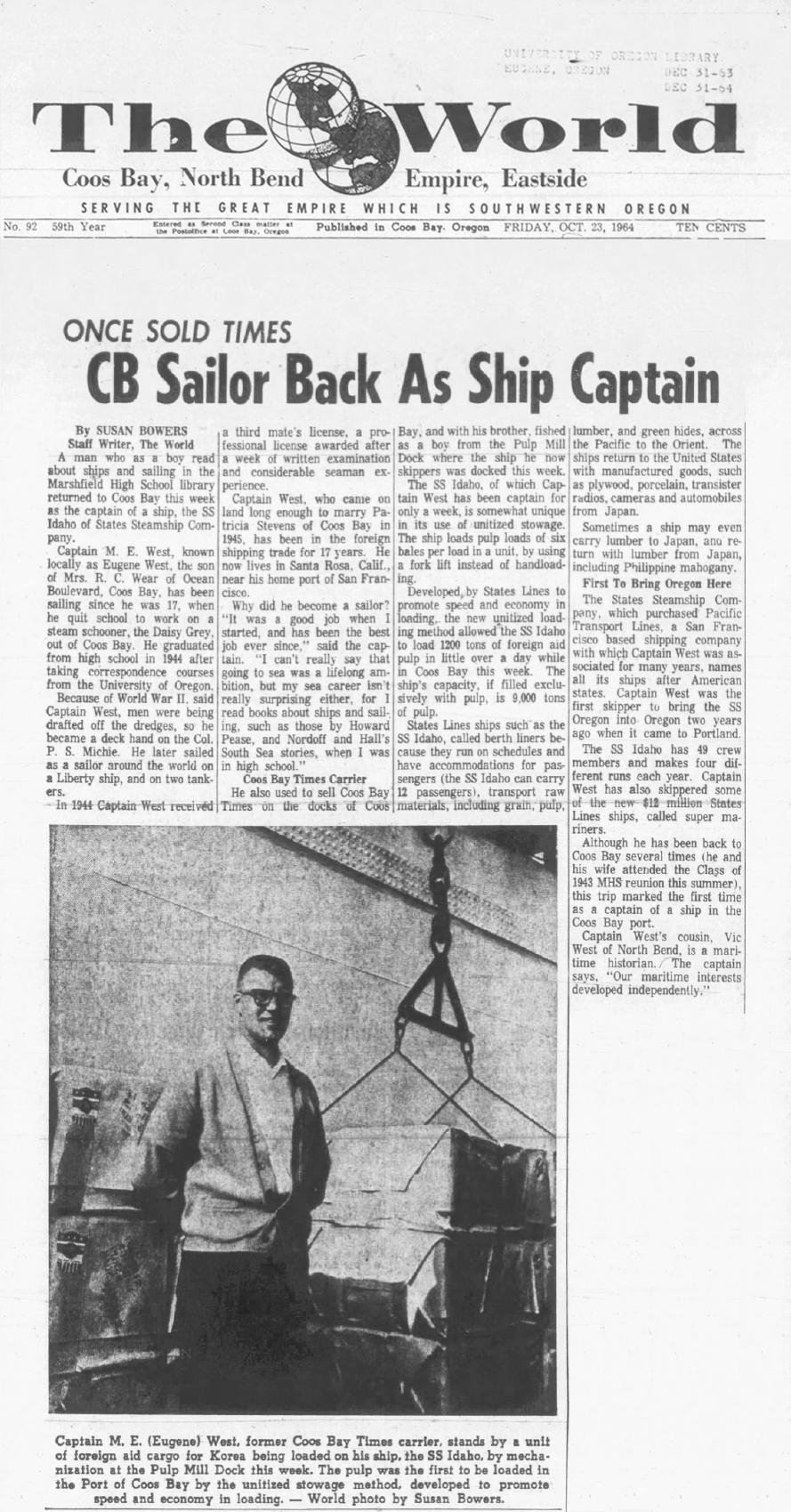
San Pedro News-Pilot, San Pedro, California • August 29, 1951
Labor troubles on the docks involve Pacific Transport Line ship, SS China Transport. There is also a story about the SS Schuyler Otis Bland. This ship was a prototype of the series C3-S-DX1 and what was to have been the "Bland class" of cargo ships, but Maritime Administration designers conceived of the even more modern "Mariner class" Type C-4 following her construction.
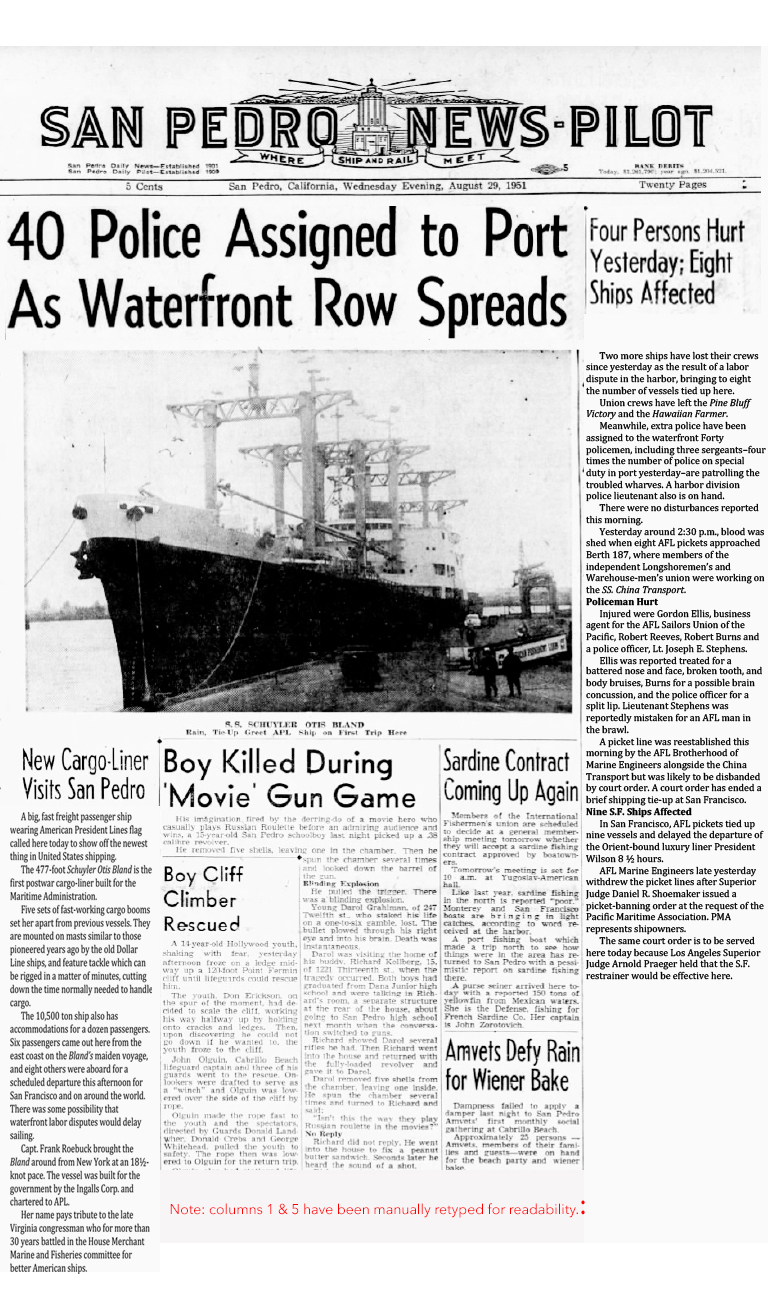
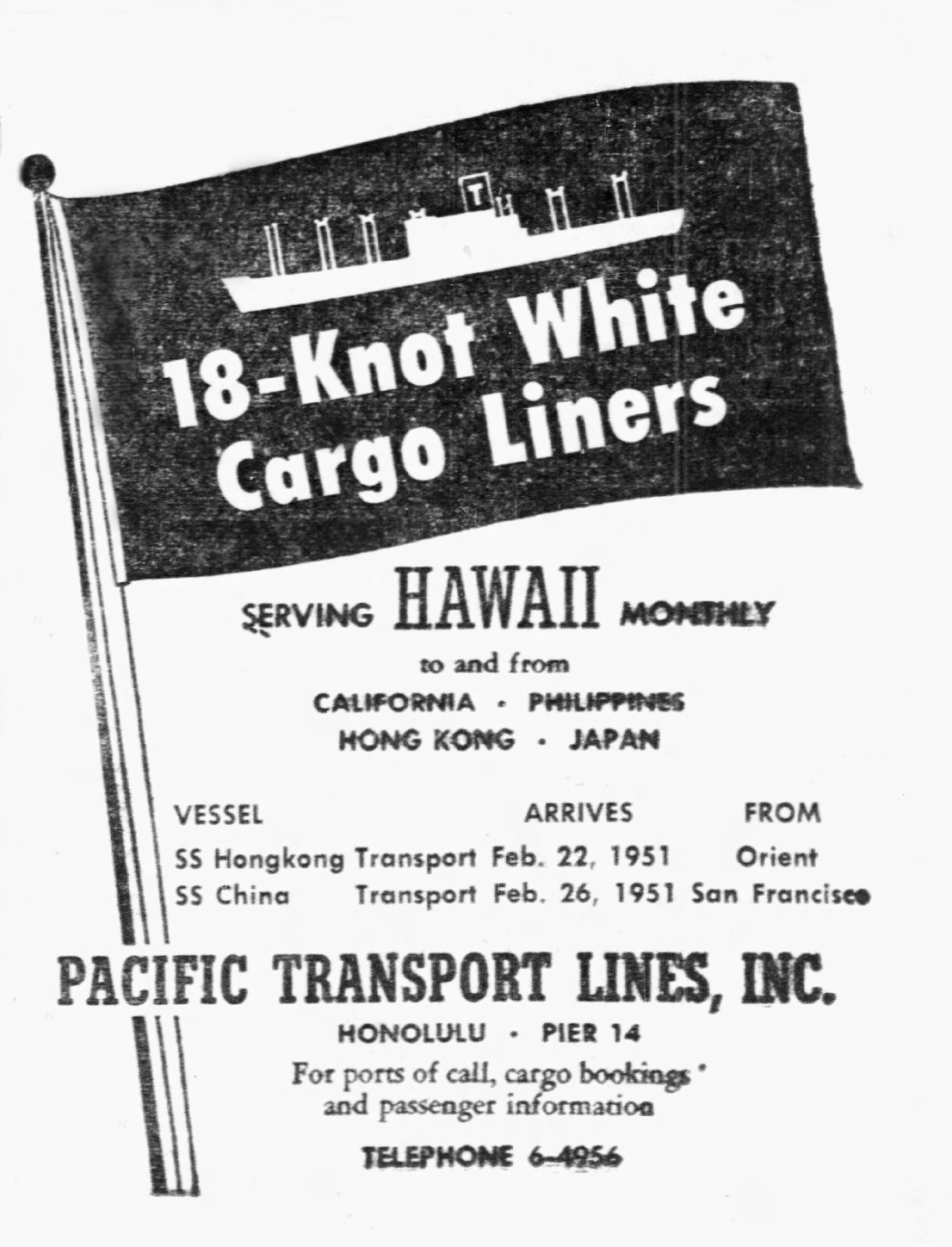
The C3 Cargo Ship, Sub-Designs and Conversions

USS Elmore (APA-42) was built on the type C-3 hull design (specifically, the C3-S-A2). Type C3-class ships were the third type of cargo ship designed by the United States Maritime Commission (MARCOM) in the late 1930s. A total of 162 C3 ships were built from 1939 to 1946. During World War II, many C3 ships were converted to naval uses, particularly as Bogue-class escort carriers, and as Bayfield-class and Windsor-class attack transports, Klondike-class destroyer tenders, submarine tenders, and seaplane tenders. After the war, many were retasked as cargo ships, as was the case with USS Elmore.
The C3 was larger and faster than the C1 and C2 contemporaries, measuring 492 feet (150 m) from stem to stern (vs. 459 feet (140 m) for the C2), and designed to make 16.5 knots (30.6 km/h; 19.0 mph) (vs. 15.5 kn (28.7 km/h; 17.8 mph) for the C2). Like the C2, it had five cargo holds. A total of 465 of these ships were built between 1940 and 1947. A total of 75 ships were built with C3 hulls and engines, but not all were built as cargo ships. Type C-4 ships were the successors to the war-era Victory ships and standard C types.
The C3-S-A2 Design Variant
Design: C3-S-A2
Cargo, Navy Amphibious Attack Transport, Escort Carrier, WSA Troop Transport, Submarine Tender
Ingalls Shipbuilding Corp., Pascagoula, Mississippi
MC-161 to 163, 388 to 393, 426 to 431, 856 to 885, 1804 to 1810 and 2589 to 2594 (58 Built / Turbine) HMS Hunter D80 (ex- Mormacpenn III), HMS Chaser D32 (ex- Mormacgulf), HMS Pursuer D73 (ex- Mormacland II), USS Custer APA-40, USS Du Page APA-41, USS Elmore APA-42, USS Fayette APA-43, USS Fremont APA-44, USS Henrico APA-45, Sea Scamp (WSA), Sea Porpoise (WSA), USS Leon APA-48, Sea Star (WSA), USS Knox APA-46, USS Lamar APA-47, USS Aegir AS-23, Sea Marlin (WSA), USS Anthedon AS-24, Sea Perch (WSA), USS Apollo AS-25, USS Clytie AS-26, USS Burleigh APA-95, Sea Owl (WSA), USS Dade APA-99, Sea Tiger (WSA), USS Mendocino APA-100, Sea Robin (WSA), USS Montour APA-101, Sea Quail (WSA), USS Riverside APA-102, USS Griggs APA-110, USS Westmoreland APA-104, USS Grundy APA-111, USS Guilford APA-112, USS Sitka APA-113, USS Hamblen APA-114, USS Hampton APA-115, USS Hannover APA-116, Sea Hawk (II), Sea Falcon, Sea Carp (II), Sea Dolphin (II), Sea Adder (II), Sea Hare (II), Sea Tarpon, Sea Triton, Sea Centaur, Sea Hydra, Marguerite Le Hand, Sea PHoenix, Sea Pegasus, Kathleen S.Holmes, William Harris Hardy, Sea Scorpion, Sea Satyr, Sea Lynx, Sea Skimmer, Sea Stallion.
Design: C3-S-A2
Cargo, Navy Amphibious Attack Transport, WSA Troop Transport
Western Pipe & Steel Co., San Francisco, California
MC-171, 174, 197 to 198, 267 to 283 and 1544 to 1557 (35 Built / Turbine) HMS Attacker D02 (ex- Steel Artisan), HMS Stalker D91 (ex- Hamlin), HMS Fencer D64, HMS Striker D12, Sea Pike (WSA), Sea Bass (WSA), USS Bolivar APA-34, USS Callaway APA-35, USS Cambria APA-36, Sea Snipe (WSA), USS Chilton APA-38, USS Clay APA-39, USS Bayfield APA-33, USS Cavalier APA-37, Sea Barb (WSA), Sea Cat (WSA), Sea Devil (WSA), Sea Flasher (WSA), USS Alpine APA-92, USS Barnstable APA-93, Sea Corporal (WSA), USS Cecil APA-96, Sea Fiddler (WSA), Sea Flier (WSA), Sea Sturgeon (WSA), Sea Runner (WSA), Sea Ray (WSA), Sea Patridge (WSA), USS Hansford APA-106, USS Goodhue APA-107, USS Goshen APA-108, USS Grafton APA-109, Sea Cardinal, Sea Shark, Sea Blenny.

Similar to type C3-S-A1 also the 55 vessels type C3-S-A2, built by Ingalls are a further development of the C3 basic design and during the war stood the test as cargo vessel and transport and after the war as cargo liner. During the war Ingalls converted 4 to Escort Carrier (CVE), 22 to Amphibious Attack Transports (APA) and 4 to Submarine Tenders (AS). Further 35 vessels were built by Western & Pipe & Steel Co.at South San Francisco, California. During the war 4 served as Escort Carriers (CVE) and 14 were converted to Amphibious Attack Transports (APA), the remaining 17 vessels served as cargo ships under War Shipping Administration custody. After the war nearly all Navy A2's were reconverted to civil standards and sold under the Merchant Sales Act of 1946. With great popularity operated by U.S. and Foreign Steamship Companies into the 1970's, a total of 15 C3-S-A2 were purchased by Matson after the war (drawing above shows one the Matson Navigation Co. A2's).
Reconversions and Conversions from the C3-S-A2 Design
Design: C3-S-A2
Containership
Mitsubishi Heavy Industries, Shimonoseki, Japan
MC-1807 (1 Converted / Turbine) Pacific Banker (ex- Marguerite Le Hand, ex- Hawaiian Craftsman)

Pacific Banker after her conversion into a container ship. Owned and operated by Matson Navigation Co. under U.S. flag and registry.
Source: US Maritime Commission Drawings



